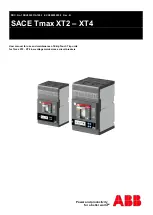
13
Interrupter/Operator Description
Opening Mode
Opening or tripping the vacuum interrupter contacts is
accomplished by rotation of the trip shaft (79). Rotation
may be produced either electrically, by energizing the trip
solenoid (266)
(Figure 15a)
, or manually by pressing the
trip button. Energizing the trip solenoid causes the upper
arm of the trip actuator (152) to rotate counterclockwise.
Pressing the trip button causes the trip actuator lower arm
to move, again producing rotation of the trip shaft. All of
the linkages are trip free, and tripping or opening is unaf-
fected by charging status of the closing springs or position
of the drive cam (20).
Rapid Auto-Reclosing Mode
The closing springs are automatically recharged by the
motor driven operating mechanism when the circuit breaker
has closed. The operating mechanism is capable of the
open-close-open duty cycle required for rapid auto-
reclosing.
For circuit breakers provided up to mid-2001, an optional
reclosing control circuit was provided. This used a trip latch
check switch and a relay (delay on dropout) to prevent
release of the closing spring energy if the trip hatchet (99)
is not in its reset position. This ensures that the mechanism
does not operate trip-free on an instantaneous reclosure.
Circuit breakers provided from mid-2001 comply with the
minimum reclose time in ANSI C37.06-2000 (table 9) of 0.3
second. It is the user’s responsibility to assure that the
required 0.3 second time delay is incorporated in the
external control scheme. This time delay is not incorporated
as an integral element of the circuit breaker mechanical
design or electrical control circuitry.
It is recognized that some users will wish to reclose with a
time delay of less than 0.3 second (300 ms). As the time
delay is decreased from 300 ms, the chances increase that a
reclose operation will fail due to excess ionization of air at
the point of the fault. It is recommended that the reclosing
relay be set to issue a reclose command no sooner than six
cycles (100 ms) after the ‘52/b’ switch makes during an
opening operation. If the reclosing relay does not monitor
the ‘52/b’ switch to determine that the circuit breaker is
open before it issues the close command, then the reclosing
relay should be set to issue the reclose command no sooner
than ten cycles (167 ms) after the opening signal is issued.
Modes of Operation - Up to Mid-1991
Pages 13-15 describe the operation of the mechanism
used from 1989 until approximately mid-1991
This mechanism can be identified by observing the close
latch above the spring charging motor on the left side of
the circuit breaker. Refer to
Figure 18
. The close hatchet
22 has a latch face which bears directly on the close shaft
72. If the close hatchet includes a bearing which contacts
a hardened latch installed on the close shaft, refer to
pages 11-13 for the description of your mechanism.
Modes of Operation Discussion
Some maintenance procedures are more easily understood
when the operating mechanism modes of operation are
described in detail. The next few paragraphs explain the
five modes or status conditions (charging, closing, trip-
free, opening and rapid auto-reclosing) of the stored
energy operating mechanism.
Note:
All discussion of modes of operation assumes that
the reader is viewing the operator from the front, or from
the right hand side.
Spring Charging Mode
Figures 14b
and
15b
show several key components of the
operator mechanism in positions corresponding to the
circuit breaker open, with the closing springs discharged
(Figure 14b)
and charged
(Figure 15b)
. Figure 16b shows
portions of the operator mechanism that manually or elec-
trically charge the closing springs. The drive cam (20), the
closing spring crank arms
(Figure 19)
and spring condition
indicator cam (18) are directly keyed to the main cam shaft
(3). The main cam shaft rotates counterclockwise. The
closing springs are attached to the crank arms, and are
extended during the charging cycle.
Figure 16b
shows the ratchet wheel (15) which is free to
rotate about the main cam shaft (3). The ratchet wheel is
driven by either the charging motor or the manual charge
handle socket (52). When the springs are charged electri-
cally, the motor eccentric (100) introduces a rocking
motion into the drive plate (13). As this plate rocks back
and forth, the lower pawl (24-1) (which is connected to
the drive plate) imparts counterclockwise rotation of the
ratchet wheel (15), one tooth at a time. The upper pawl
(24-2) acts as a holding pawl during electrical charging.
When the springs are charged manually, up and down
pumping action of the spring charging handle in the
manual charge handle socket (52) causes the pawl plate
(11) to rock back and forth through the movement of the
manual charging link (48). The upper pawl (24-2) drives
the ratchet plate counterclockwise during manual
charging, and the lower pawl (24-1) becomes the holding
device.
















































